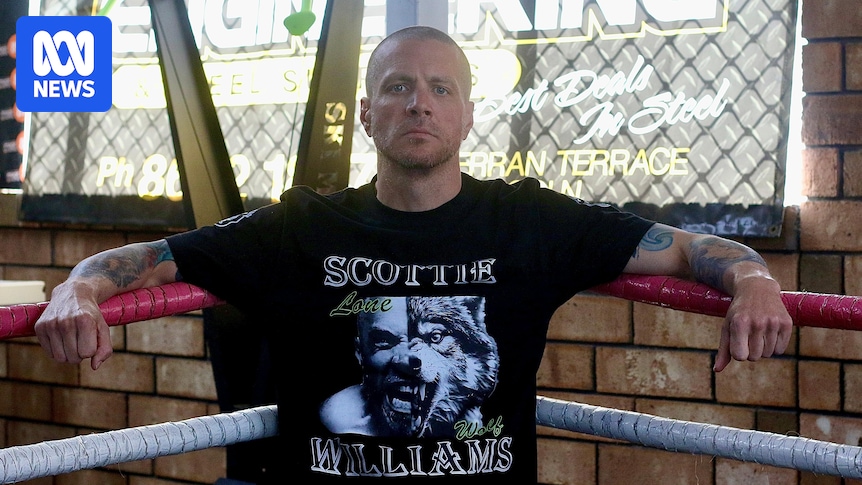The boxer in the corner of the ring leans back, sweat dripping from his brow, arms resting out to his sides.
Scottie Williams is taking a breather from a vigorous training session, days out from his first professional fight at the age of 43.
“It’s been a long time coming,” he says.
Williams has been boxing for the past 12 years, and has had success as an amateur, taking out gold in 2022 and 2023 in the novice 80 kilogram division of the Masters ring.
But now he’s ready to go professional at an age when many boxers have long since retired.
“You don’t hear of many debut 43-year-olds turning pro,” the lightweight admits.
“I want to do it, definitely want to do it and tick it off my list. Always wanted to be a pro boxer.”
Williams says he is focused on the fight. (Supplied: Isabella Slater)
Based in Port Lincoln on South Australia’s Eyre Peninsula, Williams’s working life had been as a bouncer in bars and pubs around the country, where breaking up fights often came with the territory.
But he wanted more from life.
After settling in the coastal city permanently 12 years ago, he sought out a boxing veteran to achieve a long-held dream.
Rock ‘n’ roll pro
Pete Williams (no relation) was a professional boxer in the 1970s before turning to coaching.
With more than 50 years behind him in the sport, he says a boxer turning pro in their 40s is “rare”.
But Williams is driven.
“They might have had 50 to 100 amateur fights and then they turn pro, and it’s a totally different style,” he says.
Coach Pete Williams has been training professional boxers for more than 50 years. (ABC Eyre Peninsula: Emma Pedler)
“Amateur is more hit and run and pro is rock ‘n’ roll.
“Scottie has got something to prove and he’s put in 10 times as much work as I did when I was in the ring.”
When the wannabe boxer had first approached the veteran coach in the pub to voice his interest in honing his craft, he was far from fighting fit.
“He came in [to the gym] in a wetsuit,” Pete recalls.
“I worked him hard. He had a spew out in the garden. I told him, ‘If you really want to learn, it’s all about your ears. Listen to me’.
“After a few months … he was going really well. I was in the corner [watching him fight and] covering my mouth thinking, ‘Gee, whiz. He’s doing okay.'”
It prompted a serious word of advice from the coach — the opportunity for a swipe at the big league was there if he was willing to step away from the temptations of life and focus on the ring.
Williams embraced it.
“He’s my mentor,” Williams says.
“He’s been my coach from day one. He’s saved me from some dark places, so working with Pete, half of the fight is for him as well.”
It isn’t just Williams’s drive Pete is impressed by, it is also his leadership.
So when the time came five years ago for Pete to hand over the reins of the Williams Boxing Gym, it was an easy decision to pass it onto his protege — and not just because they shared the same surname.
Williams spars regularly with fellow boxer John Hoey. (ABC Eyre Peninsula: Emma Pedler)
From there, Williams began working with the Port Lincoln Aboriginal Community Council in Youth Justice, bringing at-risk youth into the gym to teach them the value of goal-setting.
“You need to lead by example because at-risk kids follow and a good wolf always leads,” Williams says.
Old wolves having a crack
While it’s not common for boxers to enter the professional ring in their 40s, in a stroke of luck, Williams’s first pro competitor, Chris Peters, is also having his first pro fight at 44.
Peters, who has 25 amateur fights under his belt and also does jiu-jitsu, is taking on the challenge at his opponent’s insistence.
“We’re both old wolves that just want to have a crack and tick it off the bucket list,” Williams says.
Professional boxers use 10 ounce gloves and no helmets and while the safety concerns around boxing hasn’t scared Williams, it’s always on his mind.
“Hands up, move the head, move the feet, listen to the coach,” he says.
“If your coach is good enough, he will call the fight if you’re taking too much damage.
“If you get a bit of a brain haze, you need to be honest with yourself and pull up.
“You’ll end up with [chronic traumatic encephalopathy] CTE or any type of brain injury. It’s no good for your future.”
For Williams, being professional means being at the top of his strength game. (ABC Eyre Peninsula: Emma Pedler)
The professional boxing world takes brain injuries seriously, with a license from the Department of Recreation Sport and Racing needed for anyone stepping into the pro ring.
“I’ve had to up my medical insurance, get an MRI, get serologies, they test you fully,” Williams says.
As for who will win?
“A boxer with heart will beat a boxer with skill,” coach Pete Williams says.
The lightweight bout will take place this Saturday in Adelaide as part of a five-fight card.
